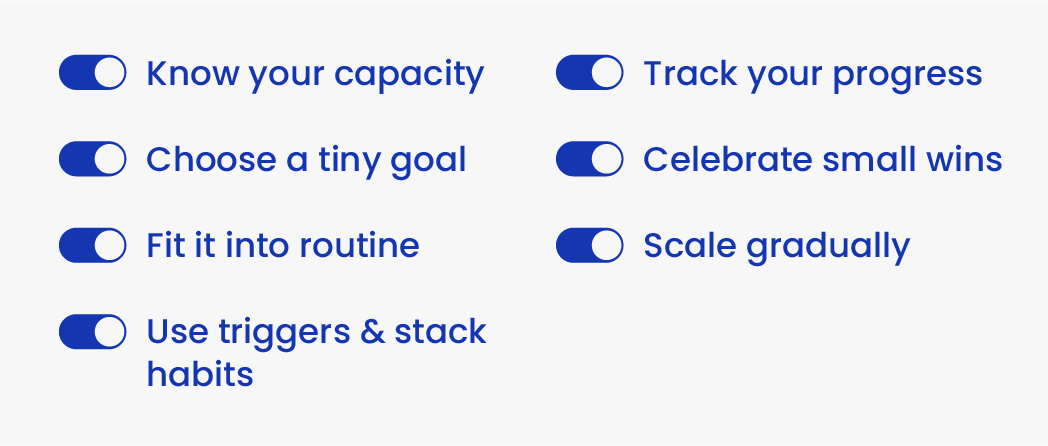Do you sometimes fall short of your long-term goals? You’re not alone. Many of us are ambitious when we set intentions, and it’s a good thing to want to improve your life. We aim to get fitter and healthier, read books instead of watching Netflix, or cook meals instead of ordering takeout—but we often lose momentum and fall short because our goals are too vague and our paths to achieving them lack focus.
This is where micro-habits can help. In this article, we’re going to discuss what micro-habits are and how you can leverage them to achieve big by starting small. Let’s get into it!
What are micro-habits?
Micro-habits are small things we can repeat daily. They require minimal effort but can lead to meaningful change over time. By starting small and staying consistent, we lay the foundation for bigger accomplishments.
For example, “improving your mental well-being" is a vague goal, making it hard to accomplish. But it can easily be broken down into smaller steps using micro-habits. Here are some popular micro-habits you can adopt to achieve this larger life goal.
Make your bed in the morning: By making the bed, you signal to yourself that you’re ready to start the day.
Write down one thing you’re grateful for each day: A daily note of gratitude can help you stay focused on what matters most to you.
Stretch hourly: Moving your body regularly throughout the day can help you stay more alert and improve your mood by stimulating your circulation.
Drink water more often: Drinking water improves digestion and lubricates your joints. Keep a bottle nearby and stay hydrated.
Read before going to sleep: Put your phone down and read a page or two before going to sleep to decrease stress and improve sleep quality.
Micro-habits like these only take a few minutes, but the overall effect can contribute to bigger goals such as staying healthy and being more mindful.
Let’s look at some of the reasons a short-term perspective on goals is better than a long-term one.

Why micro-habits work (and big goals often don’t)
The reason micro-habits are so impactful is that it’s easier to take small steps than giant leaps. Let me demonstrate with an example from my own life. When I was at university completing my master’s thesis, I felt overwhelmed by the prospect of a 10,000-word paper. Instead of feeling defeated by the length, I decided to break the big task down into small steps.
I calculated how much time I had left to finish and came up with a number. If I wrote 267 words per day, I would complete my goal on time. Suddenly, the thesis felt like a much less frightening task. I wrote “267” on a piece of paper, stuck it to the wall above my desk, and the approach worked so well that I was finished over a month ahead of schedule.
From a neurological perspective, micro-habits work because creating easily achievable goals encourages a positive feedback loop. Our brains reward us with dopamine, giving us feelings of satisfaction and pleasure when we complete a task. Large goals, on the other hand, don’t create this feedback loop. The dopamine production is reduced, and the demand on our brain’s working memory – the system our brains use to hold short-term information – is too high.
This dopamine-fueled gratification we get from micro-habits helps us stay consistent with our goals. When we are regularly rewarded for our efforts, we encourage ourselves to keep going. Since big goals only offer gratification at the end, we enjoy the task less, making consistency much more difficult to achieve.
Micro-habits can also be combined with another self-improvement concept called “habit stacking,” which isn’t as easy to do with big goals. Habit stacking is when we use our existing routine to trigger a new habit. For example, if you wanted to start taking vitamins every day, you could use your morning coffee as a trigger. Drinking coffee in the morning reminds you to take your vitamins, so you stack your existing habit with a new one.
Let’s look at how you can start to develop your own micro-habits.
Creating your own micro-habits
1. Think about what you’re capable of
Consider the responsibilities you already have (job, family, etc.) and how much time is already dedicated to them. Review your physical and mental well-being to make sure you have the capacity for your micro-habits journey.
2. Choose a goal that feels almost too easy
If your goal is simple enough, you’re less likely to talk yourself out of it. If you decide you want to meditate more, a micro-habit would be to practice mindfulness meditation for 2 – 3 minutes per day. It’s easy to find a couple of free minutes in a 24-hour day, so why not just do it?
3. Fit it into your existing routine
Micro-habits are ideally small enough to fit into our established routines. If you’re fitting yours into an 8-hour work day, try practicing it in the morning before work, at lunch, or after work. This way, you can be flexible. Because micro-habits are small and self-contained, they offer the benefit of flexibility. If your big goal is to learn a new language, for example, your micro-habit might be doing ten minutes of language study each day. You can decide when to fit it in—all that matters is that it gets done.
4. Set a trigger and implement habit-stacking
Choose something that triggers your micro-habit into action. For example, you wake up in the morning, sit for 2 minutes and meditate before breakfast. Before you have lunch, go for a walk around the block. When you structure your micro-habit, it becomes like any other daily task. Habit stacking like this makes it easier to remember to complete your micro-habits each day.
5. Track your progress
Track your micro-habit progress with a journal, calendar, or app of your choice. You’ll see the development of your micro-habit when you write down the challenges you faced and how you overcame them, or why one day was more successful than the others.
6. Celebrate your wins
Don’t forget to pat yourself on the back! Smile, say out loud, “I did it!” or text a loved one to say you’re proud of what you accomplished. You can also reward yourself with whatever brings you joy.
7. Scale gradually
If you’re making good progress, you can begin to scale your micro-habit upwards. Turn 2 minutes of meditation into 5 minutes. Walk around the block twice each day instead of once. Add another pose to your stretching routine. Do this when you’re comfortable with your micro-habit and excited to progress further. Progress should feel natural.

How to avoid challenges and stay on track
It’s normal to encounter challenges when committing to micro-habits. Full schedules, unexpected interruptions, and a tendency to revert to our old ways can all derail progress. Let’s discuss three common challenges to micro-habits and how you can get past them.
Missing days and losing momentum
Try to stick to a principle of “never miss two days in a row,” and always remind yourself that it isn’t realistic to expect perfection. The ultimate goal here is growth.
All-or-nothing thinking
When adopting a new habit, it’s easy to get frustrated by our lack of progress or failures. Engage in compassionate self-talk when you feel frustrated and use your progress tracking to identify small signs of improvement that might inspire you.
Pushing yourself too much
It’s also important to know when to step back. A new responsibility might have entered your life, or your health takes a turn. Pushing yourself despite hardships is exhausting and takes the enjoyment away. Accept that it’s okay to stop for a while or to reduce the frequency or duration of your micro-habit.

From small wins to big changes
Micro-habits are an effective way to gradually introduce meaningful changes in your life. When we focus on achievable goals, we reward ourselves more often and stay present, instead of focusing only on large goals in the distant future. Micro-habits help us stay mindful and encourage personal growth.
Living your life with micro-habits also benefits from a balanced lifestyle. Alongside our mindfulness test, you’ll find more products that promote equilibrium on the Balance section of our website.



